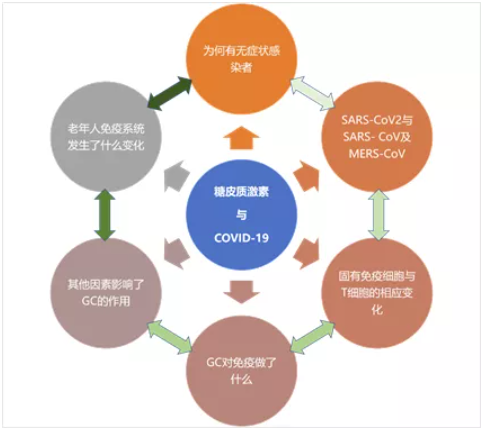[1] Ni YN, Chen G, Sun J, et al. The effect of corticosteroids on mortality of patients with influenza pneumonia: a systematic review and meta-analysis[J]. Crit Care, 2019, 23:99.
[2] Stockman LJ, Bellamy R, Garner P. SARS: systematic review of treatment effects[J]. PLoS medicine, 2006, 3:e343.
[3] Arabi YM, Mandourah Y, Al-Hameed F, et al. Corticosteroid Therapy for Critically Ill Patients with Middle East Respiratory Syndrome[J]. Am J Respir Crit Care Med, 2018, 197:757-767.
[4] Bhimraj A, Morgan RL, Shumaker AH, et al. Infectious Diseases Society of America Guidelines on the Treatment and Management of Patients with COVID-19[J]. Clin Infect Dis, 2020, ciaa478.
[5] Group RC, Horby P, Lim WS, et al. Dexamethasone in Hospitalized Patients with Covid-19[J]. N Engl J Med, 2021, 384:693-704.
[6] Mattos-Silva P, Felix NS, Silva PL, et al. Pros and cons of corticosteroid therapy for COVID-19 patients[J]. Respir Physiol Neurobiol, 2020, 280:103492.
[7] Yu L M, Bafadhel M, Dorward J, et al. Inhaled budesonide for COVID-19 in people at high risk of complications in the community in the UK (PRINCIPLE): a randomised, controlled, open-label, adaptive platform trial[J]. The Lancet, 2021, 398:843-855.
[8] Rabaan AA, Al-Ahmed SH, Haque S, et al. SARS-CoV-2, SARS-CoV, and MERS-COV: A comparative overview[J]. Infez Med, 2020, 28:174-184.
[9] Wan Y, Shang J, Graham R, et al. Receptor recognition by a novel coronavirus from Wuhan: An analysis based on decade-long structural studies of SARS[J]. J Virol, 2020, 94(7):e00127-20.
[10] Hoffmann M, Kleine-Weber H, Schroeder S, et al. SARS-CoV2 cell entry depends on ACE2 and TMPRSS2 and is blocked by a clinically proven protease inhibitor[J]. Cell, 2020, 181(2):271-280.
[11] Lansbury L, Rodrigo C, Leonardi-Bee J, et al. Corticosteroids as adjunctive therapy in the treatment of influenza[J]. Cochrane Database of Systematic Reviews, 2019, 2:CD010406.
[12] Auyeung T, Lee J, Lai W, et al. The use of corticosteroid as treatment in SARS was associated with adverse outcomes: a retrospective cohort study[J]. J Infect, 2005, 51:98-102.
[13] Blanco-Melo D, Nilsson-Payant BE, Liu WC, et al. Imbalanced Host Response to SARS-CoV-2 Drives Development of COVID-19[J]. Cell, 2020, 181:1036–1045.e9.
[14] Zuin M, Gentili V, Cervellati C, et al. Viral Load Difference between Symptomatic and Asymptomatic COVID-19 Patients: Systematic Review and Meta-Analysis[J]. Infect Dis Rep, 2021, 13:645-653.
[15] Fu E, Ma R, Wang L, et al. Study on clinical characteristics of 173 cases of COVID-19 and effect of glucocorticoid on nucleic acid negative conversion[J]. Am J Transl Res, 2021, 13:4251-4265.
[16] Wu Z, McGoogan J M. Characteristics of and important lessons from the coronavirus disease 2019 (COVID-19) outbreak in China: summary of a report of 72 314 cases from the Chinese Center for Disease Control and Prevention[J]. JAMA, 2020, 323(13):1239-1242.
[17] Chen C, Zhu C, Yan D, et al. The epidemiological and radiographical characteristics of asymptomatic infections with the novel coronavirus (COVID-19): A systematic review and meta-analysis[J]. Int J Infect Dis, 2021, 104:458-464.
[18] Issa E, Merhi G, Panossian B, et al. SARS-CoV-2 and ORF3a:nonsynonymous mutations, functional domains, and viral pathogenesis[J]. mSystems, 2020, 5(3):e00266-20.
[19] Biswas A, Bhattacharjee U, Chakrabarti AK, et al. Emergence of novel coronavirus and COVID-19: whether to stay or die out?[J]. Crit Rev Microbiol, 2020, 46(2):182–193.
[20] Toor SM, Saleh R, Sasidharan Nair V, et al. T-cell responses and therapies against SARS-CoV-2 infection[J]. Immunology, 2021, 162:30-43.
[21] Sette A, Crotty S. Adaptive immunity to SARS-CoV-2 and COVID-19[J]. Cell, 2021, 184:861-880.
[22] Moderbacher CR, Ramirez SI, Dan JM, et al. Antigen-specific adaptive immunity to SARS-CoV-2 in acute COVID-19 and associations with age and disease severity[J]. Cell, 2020, 183(4):996-1012.e19.
[23] Weiskopf D, Schmitz KS, Raadsen MP, et al. Phenotype of SARS-CoV-2-specific T-cells in COVID-19 patients with acute respiratory distress syndrome[J]. Sci Immunol, 2020, 5(48):eabd2071.
[24] Liao M, Liu Y, Yuan J, et al. Single-cell landscape of bronchoalveolar immune cells in patients with COVID-19[J]. Nat Med, 2020, 26(6):842-844.
[25] Wong JJM, Leong JY, Lee JH, et al. Insights into the immuno-pathogenesis of acute respiratory distress syndrome[J]. Ann Transl Med, 2019, 7(19):504.
[26] Chen Y, Klein SL, Garibaldi BT, et al. Aging in COVID-19: Vulnerability, immunity and intervention[J]. Ageing Res Rev, 2021, 65:101205.
[27] Chua RL, Lukassen S, Trump S, et al. COVID-19 severity correlates with airway epithelium-immune cell interactions identified by single-cell analysis[J]. Nat Biotechnol, 2020, 38(8):970-979.
[28] Shah VK, Firmal P, Alam A, et al. Overview of immune response during SARS-CoV-2 infection: lessons from the past[J]. Front Immunol, 2020, 11:1949.
[29] Chiappelli F, Khakshooy A, Greenberg G. CoViD-19 Immunopathology and immunotherapy[J]. Bioinformation, 2020, 16(3):219-222.
[30] De Biasi S, Meschiari M, Gibellini L, et al. Marked T cell activation, senescence, exhaustion and skewing towards TH17 in patients with COVID-19 pneumonia[J]. Nat Commun, 2020, 11(1):3434.
[31] Zheng HY, Zhang M, Yang CX, et al. Elevated exhaustion levels and reduced functional diversity of T cells in peripheral blood may predict severe progression in COVID-19 patients[J]. Cell Mol Immunol, 2020, 17(5):541-543.
[32] Turnbull AV, Rivier CL. Regulation of the hypothalamic-pituitary-adrenal axis by cytokines: actions and mechanisms of action[J]. Physiol Rev, 1999, 79(1):1-71.
[33] Taves MD, Ashwell JD. Glucocorticoids in T cell development, differentiation and function[J]. Nat Rev Immunol, 2021, 21:233-243.
[34] Kugler DG, Mittelstadt PR, Ashwell JD, et al. CD4+ T cells are trigger and target of the glucocorticoid response that prevents lethal immunopathology in toxoplasma infection[J]. J Exp Med, 2013, 210:1919-1927.
[35] Deobagkar-Lele M, Chacko SK, Victor ES, et al. Interferon-γ-and glucocorticoid-mediated pathways synergize to enhance death of CD4+CD8+ thymocytes during Salmonella enterica serovar Typhimurium infection[J]. Immunology, 2013, 138:307-321.
[36] Drewry AM, Samra N, Skrupky LP, et al. Persistent lymphopenia after diagnosis of sepsis predicts mortality[J]. Shock, 2014, 42(5):383-391.
[37] Wec AZ, Wrapp D, Herbert AS, et al. Broadneutralization of SARS-related viruses by human monoclonal antibodies[J]. Science, 2020, 369(6504):731-736.
[38] Hui KPY, Cheung MC, Perera R, et al. Tropism, replication competence, and innate immune responses of the coronavirus SARS-CoV-2 in human respiratory tract and conjunctiva: an analysis in ex-vivo and in-vitro cultures[J]. Lancet Respir Med, 2020, 8(7):687-695.
[39] Taneja R, Parodo J, Kapus A, et al. Delayed neutrophil apoptosis in sepsis is associated with maintenance of mitochondrial transmembrane potential (DYM) and reduced caspase-9 activity[J]. Crit Care Med, 2004, 32(7):1460-1469.
[40] Venet F, Lukaszewicz AC, Payen D, et al. Monitoring the immune response in sepsis: a rational approach to administration of immunoadjuvant therapies[J]. Curr Opin Immunol, 2013, 25(4):477-483.
[41] Rimmele T, Payen D, Cantaluppi V, et al. Immune Cell Phenotype and Function in Sepsis[J]. Shock, 2016, 45:282-291.
[42] Toor SM, Saleh R, Sasidharan Nair V, et al. T-cell responses and therapies against SARS-CoV-2 infection[J]. Immunology, 2021, 162:30-43.
[43] Ragab D, Salah Eldin H, Taeimah M, et al. The COVID-19 cytokine storm; What we know so far[J]. Front Immunol, 2020, 11:1446.
[44] Diao B, Wang C, Tan Y, et al. Reduction and functional exhaustion of T cells in patients with coronavirus disease 2019 (COVID-19)[J]. Front Immunol, 2020, 11:827.
[45] Ye Z, Zhang Y, Wang Y, et al. Chest CT manifestations of new coronavirus disease 2019 (COVID-19): a pictorial review[J]. Eur Radiol, 2020, 30:4381-4389.
[46] Quatrini L, Ugolini S. New insights into the cell- and tissue-specificity of glucocorticoid actions[J]. Cell Mol Immunol, 2021, 18:269-278.
[47] Bhattacharyya S, Brown DE, Brewer JA, et al. Macrophage glucocorticoid receptors regulate Toll-like receptor 4-mediated inflammatory responses by selective inhibition of p38 MAP kinase[J]. Blood, 2007, 109:4313-4319.
[48] Ehrchen J, Steinmüller L, Barczyk K, et al. Glucocorticoids induce differentiation of a specifically activated,anti-inflammatory subtype of human monocytes[J]. Blood, 2007, 109(3):1265-1274.
[49] Le Tulzo Y, Pangault C, Amiot L, et al. Monocyte human leukocyte antigen-DR transcriptional downregulation by cortisol during septic shock[J]. Am J Respir Crit Care Med, 2004, 169(10):1144-1151.
[50] COVID-19 Weekly Cases and Deaths per 100,000 Population by Age, Race/Ethnicity, and Sex[EB/OL]. https://covid.cdc.gov/covid-data-tracker/#demographicsovertime
[51] Confirmed COVID-19 Cases and Deaths among Residents and Rate per 1,000 Resident-Weeks in Nursing Homes, by Week-United States[EB/OL]. https://covid.cdc.gov/covid-data-tracker/#nursing-home-residents
[52] Rodier F, Campisi J. Four faces of cellular senescence[J]. J Cell Biol, 2011, 192:547-556.
[53] Franceschi C, Campisi J. Chronic inflammation (inflammaging) and its potential contribution to age-associated diseases[J]. J Gerontol A Biol Sci Med Sci, 2014, 69 Suppl 1:S4-S9.
[54] Vitale G, Salvioli S, Franceschi C. Oxidative stress and the ageing endocrine system[J]. Nat Rev Endocrinol, 2013, 9:228-240.
[55] Radzikowska U, Ding M, Tan G, et al. Distribution of ACE2, CD147, CD26 and other SARS-CoV-2 associated molecules in tissues and immune cells in health and in asthma, COPD, obesity, hypertension, and COVID-19 risk factors[J]. Allergy, 2020, 75(11):2829-2845.
[56] Chen J, Zhang ZZ, Chen YK, et al. The clinical and immunological features of pediatric COVID-19 patients in China[J]. Genes Dis, 2020, 7(4):535-541.
[57] Moratto D, Giacomelli M, Chiarini M, et al. Immune response in children with COVID-19 is characterized by lower levels of T-cell activation than infected adults[J]. Eur J Immunol, 2020, 50(9):1412-1414.
[58] Liu Y, Pan Y, Hu Z, et al. Thymosin alpha 1 (Talpha1) reduces the mortality of severe COVID-19 by restoration of lymphocytopenia and reversion of exhausted T cells[J]. Clin Infect Dis, 2020, 71(16):2150-2157.
[59] Briceño O, Lissina A, Wanke K, et al. Reduced naı¨ve CD8(+) T-cell priming efficacy in elderly adults[J]. Aging Cell, 2016, 15(1):14-21.
[60] Calzetta L, Aiello M, Frizzelli A, et al. Dexamethasone in Patients Hospitalized with COVID-19: Whether, When and to Whom[J]. J Clin Med, 2021, 10(8):1607.
[61] Yadav H, Thompson BT, Gajic O. Fifty Years of Research in ARDS. Is Acute Respiratory Distress Syndrome a Preventable Disease?[J]. Am J Respir Crit Care Med, 2017, 195:725-736.
[62] Valles J, Fontanals D, Oliva JC, et al. Trends in the incidence and mortality of patients with community-acquired septic shock 2003-2016[J]. J Crit Care, 2019, 53:46-52.
[63] Valles J, Diaz E, Martin-Loeches I, et al. Evolution over a 15-year period of the clinical characteristics and outcomes of critically ill patients with severe community-acquired pneumonia[J]. Med Intensiva, 2016, 40:238-245.。
[64] Villar J, Ferrando C, Martínez D, et al. Dexamethasone treatment for the acute respiratory distress syndrome: a multicentre, randomised controlled trial[J]. Lancet Respir Med, 2020, 8(3):267-276.
[65] Annane D, Bellissant E, Bollaert PE, et al. Corticosteroids for treating sepsis in children and adults[J]. Cochrane Database Syst Rev, 2019, 12:CD002243.
[66] Annane D, Renault A, Brun-Buisson C, et al. Hydrocortisone plus Fludrocortisone for Adults with Septic Shock[J]. N Engl J Med, 2018, 378:809-818.


 后可发表评论
后可发表评论




 公众号
公众号
 客服微信
客服微信